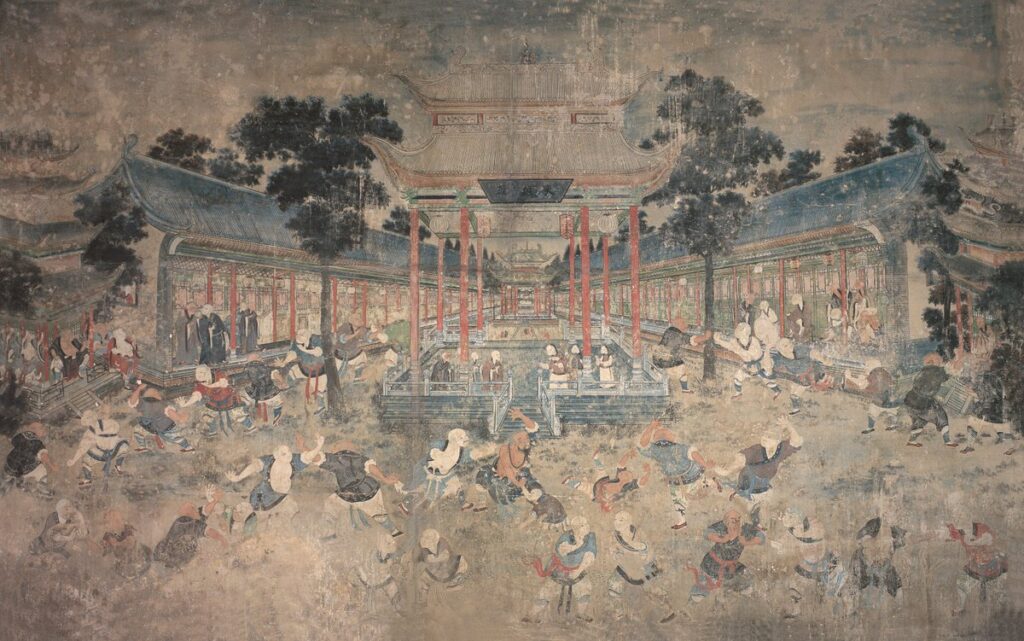
Introduction
In the heart of Henan province, atop the mist-shrouded peaks of Songshan Mountain, lies the cradle of martial arts mastery and spiritual enlightenment—the Shaolin Temple. Beyond its reputation for Shaolin Kung Fu, the history of the temple reveals a tale of strategic foresight and a unique location that played a pivotal role in its formation.
The Formation of Shaolin Temple
Founded in the 5th century, the Shaolin Temple owes its existence to the vision of an Indian Buddhist monk named Bodhidharma. Seeking a serene and isolated location to cultivate both mind and body, Bodhidharma discovered the ideal spot on the slopes of Songshan Mountain. The rugged terrain and dense forests provided a natural fortress, ensuring solitude and tranquility for those seeking spiritual enlightenment.

Strategic Location
The selection of Songshan Mountain as the site for Shaolin Temple was not arbitrary; it was a strategic decision that served both spiritual and practical purposes.
- Isolation and Meditation:
- The mountainous surroundings offered seclusion, shielding the monks from external distractions. This isolation facilitated deep meditation and introspection, allowing the monks to delve into their spiritual practices undisturbed by the chaos of the outside world.
- Natural Defenses:
- The rugged landscape, with its steep cliffs and dense vegetation, served as a natural barrier against potential invaders. The temple’s elevated position provided a vantage point, offering early warning against approaching threats. This geographical advantage allowed the monks to focus on their spiritual pursuits without constant concern for external dangers.
- Access to Resources:
- The temple’s location amid the natural beauty of Songshan Mountain provided access to essential resources. Freshwater streams, medicinal herbs, and fertile soil supported the monks’ self-sufficiency, enabling them to lead a sustainable and contemplative life.
- Cultural Exchange:
- Positioned along ancient trade routes, the Shaolin Temple became a cultural crossroads. Pilgrims, scholars, and martial artists from distant lands converged at this sacred site, contributing to the exchange of ideas, philosophies, and martial arts techniques.
Sanctuary In Turmoil

The Warring States Period
The origins of Shaolin Temple coincide with the chaotic Warring States Period (475–221 BCE), a time marked by incessant warfare and territorial disputes among feudal states. Faced with the perils of violence and political turmoil, martial artists and monks sought sanctuary in the mountains, drawn to the serenity and strategic advantage offered by Songshan Mountain.
Refuge for the Displaced
As neighboring regions became battlegrounds, martial artists and monks found themselves displaced, their lives upended by the ravages of war. Seeking refuge within the formidable natural defenses of Songshan Mountain, they joined the burgeoning community at Shaolin Temple. Here, amidst the misty peaks, they discovered not only safety but also a community of like-minded individuals dedicated to the pursuit of spiritual enlightenment and martial excellence.
The Tang Dynasty and Political Unrest
The Tang Dynasty (618–907 CE) brought about a flourishing period for the Shaolin Temple, marked by imperial patronage and the temple’s role in safeguarding the northern frontier. However, as political instability gripped the dynasty during the later years, the temple once again became a haven for those seeking refuge from the chaos.
Martial Masters as Guardians
Prominent martial arts masters, recognizing the strategic importance of the Shaolin Temple, aligned themselves with its mission. They became guardians of the temple, both defending it from external threats and imparting their martial wisdom to the monks within. This alliance between skilled martial artists and devoted monks contributed to the development of the unique martial art form known today as Shaolin Kung Fu.
The Ming and Qing Dynasties
During the Ming (1368–1644 CE) and Qing (1644–1912 CE) dynasties, political upheaval once again enveloped China. The Shaolin Temple faced challenges as external forces sought to suppress rebellions and eliminate potential threats. Martial artists flocked to the temple, not only for sanctuary but also to contribute to the resistance against oppressive rule.
Preservation through Secrecy
Faced with the constant threat of persecution, the monks of Shaolin Temple were compelled to preserve their martial arts knowledge through secrecy. They developed unique training methods and concealed the true depth of their skills, ensuring the survival of Shaolin Kung Fu through generations.
Conclusion:
The formation of Shaolin Temple on Songshan Mountain was not a mere coincidence; it was a deliberate choice that blended spirituality with strategic advantage. The natural barriers of the mountainous terrain provided protection, allowing the monks to dedicate themselves to both martial and spiritual pursuits. Today, as we marvel at the legacy of Shaolin Kung Fu, we must also appreciate the wisdom behind the selection of Songshan Mountain—a haven that nurtured the birth of serenity amidst the peaks and a beacon of resilience in times of turmoil.




